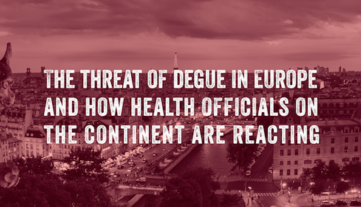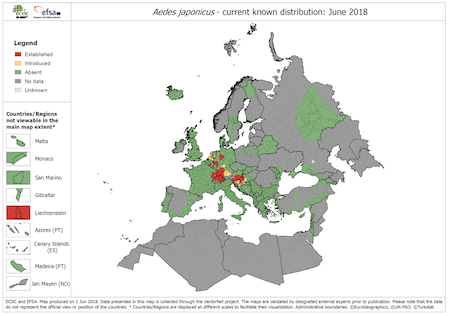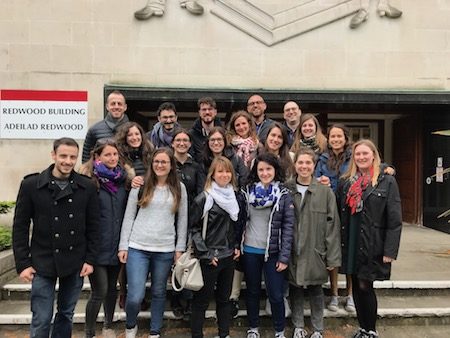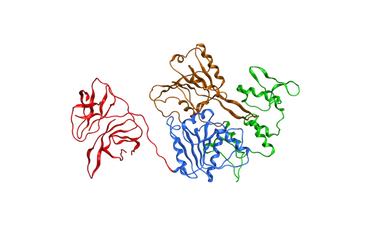- by Alison
The threat of dengue in Europe and how the continent is reacting

The threat of dengue in Europe has become a reality. At the tail end of 2018, autochthonous dengue cases appeared in Spain and France, and its vector, Aedes albopictus, has spread ever further north and was recently reported in Eindhoven. The lesser-known and less capable vector Aedes japonicus is expanding its presence across central Europe. But, most worryingly, the climate and environment remain favorable for primary vector Aedes aegypti to become established once more. We spoke with two experts involved in EU-funded Actions to combat Aedes and dengue: Dr. William Wint, Senior Research Associate in the Zoology Department at Oxford University, and Dr. Giulio Nannetti, Post-Doctoral Research Associate in the School of Pharmacy and Pharmaceutical Sciences at Cardiff University to learn more about the threat of dengue in Europe.

Image via the ECDC
Our first conversation focused on dengue vectors: mosquitoes in the genus Aedes. Dr. Wint began by explaining the current status of Aedes in Europe: “The Asian tiger mosquito has been spreading in Europe for more than two decades. It’s a real nuisance that spreads very quickly and is now recorded in most of the EU. Aedes japonicus came into Europe more recently and is spreading in all directions from south-central Europe, where it was first introduced. It is also spreading northwards in Germany, reaching the latitudes of south-central UK.”
Aedes aegypti largely vanished from Europe in the 1950s, possibly because piped water introduced after the war led to a decline in the rain butts and other water containers that were the main breeding sites for its larvae. “The European climate remains suitable for the vector, indeed increasingly so, and it’s now spreading west along the Turkish Black Sea coast,” said Dr. Wint. “Why it hasn’t yet found its way back into the rest of the EU is a real mystery”.
The AIM COST action
Dr. Wint leads one of the three working groups set up by the Aedes Invasive Mosquitoes (AIM) COST Action, an initiative funded by COST (European Cooperation in Science and Technology) to build a network of European stakeholders to strengthen Europe’s capacity to combat Aedes mosquitoes, and the spread of dengue in Europe. The action, according to COST, will “assess and review current surveillance, control, and analysis practices, develop best practice guidelines and protocols ensuring consistency across Europe”.
“Aedes are competent vectors of a range of diseases,” said Dr. Wint. “It serves us well to harmonize the guidelines for surveillance and control within Europe; if people do things differently – do surveillance at different times of the day or use different numbers of samples, for instance – it’s much more difficult to build a comparable picture of what’s happening across the continent.”
The project may also tailor the guidelines so more people can understand what needs to be done and, in some cases, help with control or surveillance efforts.
A broad spectrum of participants
Beyond developing guidelines, the AIM COST action will also measure its success on building and sustaining relationships, organizing funded projects and increasing understanding of the action, its activities and the status of Aedes in Europe. Bearing these in mind, the breadth of participation is not surprising.
The network is run by Alessandra della Torre, Associate Professor at the Sapienza University of Rome in Italy, and Professor Dušan Petrić from the University of Novi Sad in Serbia. It is primarily made up of entomologists, many of them early in their careers, alongside experts in dengue genetics, in mosquito control and surveillance, and in mapping. Its management committee comprises two qualified professionals as national representatives from each of the 35 countries involved. Dr. Wint represents the UK alongside Dr. Jolyon Medlock from Public Health England, for instance.
International agencies, such as the European Centre for Disease Prevention and Control (ECDC), the World Health Organization (WHO) and the European Mosquito Control Association, will also participate, alongside other national agencies and organizations.
“We’re also hoping to get ordinary people involved through Citizen Science,” says Dr. Wint. “We need feedback on how important people think this is. We also want to keep the public informed and to ensure anything anyone does is compatible with the more formal things scientists and technicians do.”
Reducing the threat of dengue in Europe through focused workgroups
One of the action’s first tasks was forming three work groups, each with a distinct role: one developing the harmonized monitoring/surveillance guidelines, one developing the harmonized control guidelines and one, which Dr. Wint leads, making sure that the work the other groups produce gets out into the real world. Dr. Wint tells us his group will “go out and find out what people expect of the guidelines, how they want them presented, who they should go to … even find out whether the maps produced by the other two work groups are in the right colors and format.”
The project also has a Science Communication officer whose role is to ensure the information reaches the right places and “not just journals or agencies but to a much broader audience.” Social media will play an important role.
The four-year project kicked off in September with a meeting of national representatives in Brussels, at which the leaders of the action’s three workgroups revealed and gained buy-in for their plans. The first AIM-COST Annual Conference is scheduled to take place in Athens from 12th – 14th February.
Our second conversation focused on dengue itself – more specifically the development of a new treatment aimed at preventing dengue infections from progressing to severe forms of the disease.
Developing a new dengue treatment
With the prospect of dengue arriving in Europe, Dr. Nannetti is working under the supervision of Professor Andrea Brancale on an EU-funded project to develop innovative broad-spectrum antiviral compounds to combat all four serotypes of the dengue virus. “The lack of specific treatment for dengue fever makes the development of new anti-dengue strategies critical,” says Dr. Nannetti. “They would have an enormous impact on public health worldwide, potentially preventing significant costs and economic loss.”

Image: The team at Brancale’s lab fighting the threat of dengue in Europe.
Funded under the Marie Skłodowska-Curie Actions, the University of Cardiff FINDER (FIghtiNg DEngue virus) project is partnering with the laboratory of Professor Arianna Loregian at the University of Padova in Italy to find a way to stop the dengue virus from replicating, using an approach similar to one he previously used to develop anti-flu compounds.
It has previously been observed that higher amounts of the dengue virus (or a higher viral load) in patients’ blood patients increases the risk of developing severe disease. That observation suggested that a good dengue antiviral could limit and revert the progression of the disease.
“We aim to disrupt the interaction between viral proteins that the dengue virus needs to replicate,” says Dr. Nannetti. “We have, to date, used computer-aided drug design approaches to identify a promising druggable target (a portion of a virus protein that can be bound well by a drug) for all four dengue serotypes.” The team used the target as a template to screen for compounds that could potentially inhibit the dengue virus and are now testing these molecules.

Image of the dengue NS3 protein courtesy of Dr. Nannetti
Drug development is a long and complex process that can take more than a decade. By the end of his two-year fellowship, Dr. Nannetti expects to have identified one or more non-toxic candidate drugs capable of interfering with the dengue virus replication in cellular systems. “Next steps would then be to evaluate the antiviral activity of these anti-dengue candidates in preclinical models,” he concludes.
If you’re working to combat the threat of dengue in Europe or developing novel treatments to combat the dengue virus itself, please get in touch. We’d love to hear from you.
—
Now you can get updates of dengue activity in your area and help experts to reduce the impact of this disease. Click below to report dengue incidence to Dengue Track.

